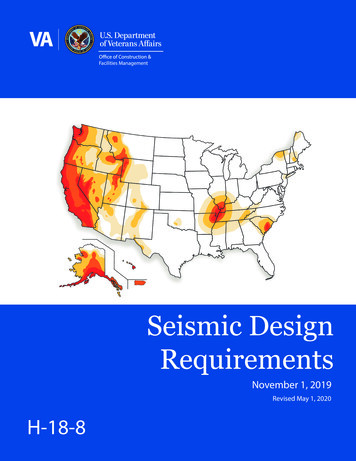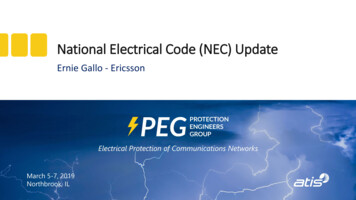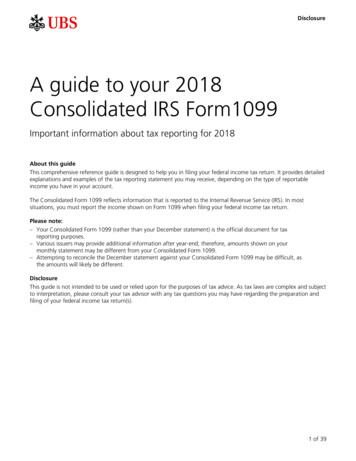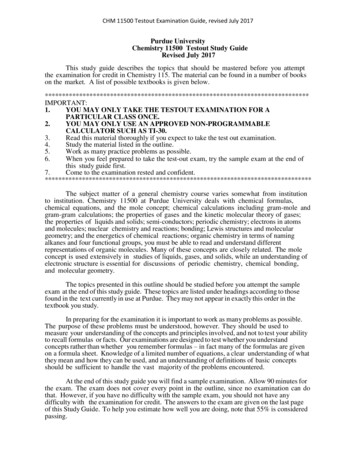
Transcription
Facilities ManagementSeismic DesignRequirementsNovember 1, 2019Revised May 1, 2020H-18-8
VA Handbook 18-8Seismic Design RequirementsFOREWORDNovember 1, 2019Revised May 1, 2020BackgroundIn 1971, after the San Fernando earthquake resulted in the death of 46 patients and staff whentwo VA buildings collapsed, VA began to undertake a full seismic safety program. Title 38 - UnitedStates Code, section 8105 required the Secretary to assure that each medical facility constructedor altered shall be of construction that is resistant to fire, earthquake, and other natural disasters.This initiated the creation of the Secretary’s Advisory Committee on Structural Safety of VAFacilities, which formally approved in 1975 the original VA Seismic Design document, H-08-8,Earthquake Resistant Design Requirements for VA Facilities. These requirements were developedwith the concept that all VA Essential Facilities must remain in operation after an earthquake andwere far in advance of National Codes.This document is periodically updated and revised. The revision of H-08-8 to H-18-8 in 1995 was amajor rewrite to bring VA seismic design requirements more in line with the updated nationalmodel codes. Further updates/revisions of minor nature were made in 1997, 1998, 2000, 2002,2003, 2005, 2006, 2008, 2010, 2011, 2013, and 2016.Current Revision Highlights: Referenced versions of national codes and standards updated to the latest date-specific editionsat the time this standard was published. Definitions of Critical, Essential, and Ancillary facilities have been clarified in Sections 1.4 and 7.0. Section 2.5 corrects an error in the October 1, 2016 edition of H-18-8 that inadvertently excludedAncillary facilities from the requirement to use nonlinear procedures for retrofit. Outdated exemptions for existing structures and nonstructural components and equipment wereremoved and the Importance Factor, Ip, for all nonstructural components is set to 1.5 for Criticalfacilities in Seismic Design Categories C, D, E, and F, consistent with California’s Office of StatewideHealth Planning & Development (OSHPD) provisions. In Section 4.2, reference to an outdated OSHPD Code Application Notice (CAN) regarding ruggedequipment was replaced with lists of typical equipment requiring Special Seismic Certification andrugged equipment exempt from certification.Note: A vertical bar is placed to the right of the revised sections.John G. Bulick Jr.Acting Associate Executive DirectorOffice of Facilities PlanningNovember 1, 2019i
VA Handbook 18-8Seismic Design RequirementsNovember 1, 2019Revised May 1, 2020TABLE OF CONTENTS1.0 Definitions . 12.0 General . 33.0 Modifications to Requirements of IBC for NewCritical and Essential Facilities Assigned to High Seismic Design Categories . 64.0 Elements of Structures, Nonstructural Components,and Equipment Supported by Structures for Critical and Essential Facilities . 95.0 Site Data for Critical and Essential Facilities . 126.0 Commentary . 147.0 Risk Categories . 16ii
VA Handbook 18-8Seismic Design RequirementsNovember 1, 2019Revised May 1, 20201.0 DEFINITIONS1.1 AISC 341 1: AISC 341-16, Seismic Provisions for Structural Steel Buildings.1.2 ASCE 7 1: ASCE/SEI 7-16, Minimum Design Loads and Associated Criteria for Buildings andOther Structures, American Society of Civil Engineers, .1.3 ASCE 41 1: ASCE/SEI 41–17, Seismic Evaluation and Retrofit of Existing Buildings, AmericanSociety of Civil Engineers.1.4 Category of Facilities:a) Critical Facilities: Buildings and other structures that are intended to remain fullyfunctional after the design level earthquake or other natural disaster such as hurricane,tornado, etc. These facilities include, but are not limited to, the VA occupancycategories listed as Critical Facilities in Tables 4 and 7, and they shall be assigned to RiskCategory IV.b) Essential Facilities: Buildings and other structures that are intended to maintainessential functions with minor repairs after the design level earthquake or other naturaldisaster such as hurricane, tornado, etc. These facilities include, but are not limited toVA occupancy categories listed as Essential Facilities in Tables 5 and 7, and they shall beassigned to Risk Category III.c) Ancillary Facilities: These buildings and other structures include, but are not limited to,the VA occupancy categories listed as Ancillary Facilities in Tables 6 and 7. All ancillaryfacilities shall be designated as non-essential facilities, and shall be assigned to RiskCategory II.1.5 IBC 1: 2018 International Building Code.1.7 OSHPD: Office of Statewide Health Planning & Development, State of California.1.8 Risk Category: A categorization of buildings and other structures used to determinenatural hazard design loads based on the risk associated with unacceptable performancedue to the nature of the occupancy, as defined in Section 7.0, and translated to IBC RiskCategories II, III, and IV specified in Section 1.4.Errata, addenda, supplements, and interpretations, if any, for this code or standard shall beadopted.11
VA Handbook 18-8Seismic Design RequirementsNovember 1, 2019Revised May 1, 20201.9 RP 8 1: Standards of Seismic Safety for Existing Federally Owned and Leased Buildings,Interagency Committee on Seismic Safety in Construction (ICSSC) Recommended Practice8 (RP 8), The National Institute of Standards and Technology (RP 8 is available .10 Seismic Design Category: As defined in ASCE 7, a classification assigned to a structurebased on its risk category and the severity of the design earthquake ground motion at thesite.1.11 Soft Story & Extreme Soft Story: As defined in ASCE 7, Table 12.3-2.1.12 Spectral Response Acceleration: A parameter used to characterize the anticipatedearthquake shaking at the location of the specific facility under consideration.Ss: Spectral response acceleration parameter at short periods corresponding to themapped maximum considered earthquake.S1: Spectral response acceleration parameter at a period of 1 sec corresponding to themapped maximum considered earthquake.SDS: Design spectral response acceleration parameter at short periods adjusted for siteclass effects, as defined in ASCE 7.SD1: Design spectral response acceleration parameter at a period of 1 sec adjusted for siteclass effects, as defined in ASCE 7.1.13 VA Seismic Safety Coordinator: A VA Designated Seismic Safety Coordinator in the Officeof Facilities Planning (OFP) within the Office of Construction & Facilities Management(CFM), responsible for reporting VA compliance with Executive Order 13717, Establishinga Federal Earthquake Risk Management Standard. When the VA Seismic SafetyCoordinator is referenced in this manual for approvals, the Associate Executive Directorfor OFP also maintains the same approval authority.2
VA Handbook 18-8Seismic Design Requirements2.0 GENERALNovember 1, 2019Revised May 1, 2020These requirements cover all VA facilities including those of National Cemetery Administration,Veterans Benefits Administration, and Veterans Health Administration.2.1 New Critical and Essential FacilitiesAll new Critical and Essential Facilities shall be designed and constructed in full compliancewith the earthquake design and detailing requirements of IBC as modified in theseprovisions.2.2 New Ancillary FacilitiesAll new Ancillary Facilities shall be designed and constructed in full compliance with theearthquake design and detailing requirements of IBC with no additional modifications.2.3 Existing FacilitiesEvaluation and retrofit of all existing facilities shall comply with the minimum RP 8standards as modified in these provisions, including triggers for evaluation and potentialmitigation in Section 2.4.2.4 Existing Facilities - Evaluationa.In addition to the RP 8 Section 2.1 triggers, a seismic evaluation and potentialmitigation shall be conducted for existing Critical and Essential facilities in areaswhere SDS 0.167 and SD1 0.067 and Ancillary Facilities in areas where SDS 0.330and SD1 0.133 that meet one or more of the following criteria:i. Facilities selected for renovation as part of a VA Major Construction project.ii. Facilities assigned to Seismic Design Category C, D, E, or F that are selected forrenovation where the area of renovation is greater than 50% of the total area.iii A project is planned which significantly extends the building’s useful life throughalterations or repairs which total more than 30% of the replacement value of thefacility. This applies for facilities assigned to Seismic Design Category C, D, E, orF.iv. Facilities under consideration by VA for lease with total floor area greater than10,000 ft2.v. A significant addition to an existing building is planned that is not structurallyindependent of the existing building is planned.vi. A building is being relocated from its current site.b.Existing Critical, Essential, and Ancillary Facilities shall be evaluated using theprocedures in ASCE 41 for the performance objectives in accordance with Table 1.3
VA Handbook 18-8Seismic Design RequirementsNovember 1, 2019Revised May 1, 20202.5 Existing Facilities – RetrofitAll Critical, Essential, and Ancillary existing facilities shall be retrofitted using Tier 3 nonlinearprocedures described in ASCE 41 to achieve the performance objectives in accordance withTable 1.2.6 Existing Facilities Performance Objectives for Evaluation and RetrofitThe performance objectives used for Evaluation and Retrofit are shown in Tables 1-3 and aredefined in ASCE 41, and shall be applied for each applicable Tier (1-3) used forscreening/evaluation and retrofit procedures.Table 1. Performance ObjectivesDescriptionEvaluationRetrofitAll triggered situations in Section 2.4.a and RP 8 Section 2.1,unless noted otherwise belowBPONBPONDamaged structures described in RP 8 Section 2.1(d)BPOEBPOELeased spaceBPOEBPOETable 2. Basic Performance Objectives Equivalent to New Building Standards (BPON)Risk CategoriesCritical and EssentialCritical and EssentialAncillaryAncillarySeismic Hazard LevelBSE-1NBSE-2NImmediate OccupancyStructural PerformanceLife Safety StructuralPerformanceOperational NonstructuralPerformanceHazards ReducedNonstructural PerformanceLife Safety StructuralPerformanceCollapse PreventionStructural PerformancePosition RetentionNonstructural PerformanceHazards ReducedNonstructural Performance4
VA Handbook 18-8Seismic Design RequirementsNovember 1, 2019Revised May 1, 2020Table 3. Basic Performance Objectives Equivalent to Existing Building Standards (BPOE)Risk CategoriesSeismic Hazard LevelBSE-1ECritical and EssentialCritical and EssentialAncillaryAncillaryBSE-2EImmediate OccupancyStructural PerformanceLife Safety StructuralPerformancePosition RetentionNonstructural PerformanceHazards ReducedNonstructural PerformanceLife Safety StructuralPerformanceCollapse PreventionStructural PerformanceLife Safety NonstructuralPerformanceHazards ReducedNonstructural Performance2.7 Existing Facilities Retrofit – Alternative ApproachAn alternative approach may be permitted on a case-by-case basis upon approval by theVA Seismic Safety Coordinator for Critical and Essential Facilities to be strengthenedaccording to procedures in ASCE 41.5
VA Handbook 18-8Seismic Design RequirementsNovember 1, 2019Revised May 1, 20203.0 MODIFICATIONS TO THE REQUIREMENTS OF ASCE 7 FOR NEW CRITICAL AND ESSENTIALFACILITIES ASSIGNED TO HIGH SEISMIC DESIGN CATEGORIES3.1 Structural Irregularities (ASCE 7, Section 12.3.3)For structures assigned to Seismic Design Categories D, E, or F, the following types ofvertical irregularities as defined by ASCE 7 Table 12.3-2 are not allowed:a.b.c.d.Stiffness irregularity – Soft StoryStiffness irregularity – Extreme Soft StoryWeight (mass) irregularityVertical geometric irregularity3.2 Seismic-force-resisting-systems (ASCE 7, Table 12.2-1)The following structural systems are permitted for new Critical and Essential Facilitiesassigned to Seismic Design Categories D, E, or F.a.Building Frame Systemsi.ii.iii.iv.v.vi.b.Steel eccentrically braced frames (EBF) moment resisting connections at columnsaway from linksSpecial reinforced concrete shear walls (Building Frame)Special reinforced masonry shear walls (Building Frame)Special steel concentrically braced framesLight frame walls with shear panels-wood structural panels/sheet steel panels(Building Frame) for structures two stories or lessBuckling-restrained braced frames, moment-resisting beam-column connectionsMoment-Resisting Frame Systems, if approved by the VA Seismic Safety Coordinator.i. Special steel moment-resisting frames (SMRF)ii. Special reinforced concrete moment-resisting framesc.Dual Systemsi.ii.iii.iv.v.Special reinforced concrete shear walls with SMRFSpecial reinforced masonry shear walls with SMRFSteel EBF with SMRFSpecial steel concentrically braced frame with SMRFBuckling-restrained braced frameOther structural systems as permitted by the ASCE 7 for Seismic Design Categories D, E orF, including ones that employ seismic isolation and seismic damping systems arepermitted subject to written approval by the VA Seismic Safety Coordinator. Proposals to6
VA Handbook 18-8Seismic Design RequirementsNovember 1, 2019Revised May 1, 2020obtain written approval for other structural systems shall demonstrate the equivalentperformance of those systems, relative to the permitted systems, considering (a) initialconstruction and maintenance costs, (b) requirements for bracing non-structuralcomponents and building contents, (c) risk of economic losses and disruption to hospitalfunctions due to earthquakes and (d) other demonstrable benefits.3.3 Special Provisions for structures assigned to Seismic Design Categories D, E, or F.The provisions of this section shall apply to all new Critical and Essential Facilities.a.Bay spacing essentially shall be equal and uniform throughout.b.Transfer beams or trusses supporting upper level columns shall not be used unlesspermitted on a case by case basis by the VA Seismic Safety Coordinator.c.Seismic joints shall be avoided, if at all possible. When required, they shall bespecifically identified in the schematic design phase of the project and approved bythe VA Seismic Safety Coordinator, subject to the following provisions:i. Seismic joints shall be properly detailed on the working drawings;ii. Seismic joints shall be sized based on the maximum expected displacements,considering the effects of story drift, diaphragm displacements and rotations,and a realistic approximation of element section properties. For materialsdesigned considering the ultimate limit state, such as concrete, the stiffnessrepresentative of this state shall be used. Seismic separations shall be 125% ofthe separation required by ASCE 7; andiii. Adjacent structures that are not integral with an existing structure shall beseparated by not less than 2 inches per story.3.4 Limitations on Reinforced Concrete StructuresThe provisions of this section shall apply to all new Critical and Essential Facilities assignedto Seismic Design Categories D, E, or F.a.Prestressed concrete structural members, including pre-tensioned and posttensioned members, and precast elements such as tilt-up wall panels, and precastbeam and column elements shall not be used to resist seismic forces.b.Lightweight concrete shall not be used in structural members resisting earthquakeforces, except in concrete floors and roof slabs used as diaphragm elements todistribute earthquake forces to vertical lateral-load resisting elements.7
VA Handbook 18-8Seismic Design Requirements3.5 Limitations on Steel StructuresNovember 1, 2019Revised May 1, 2020The provisions of this section shall apply to all new Critical and Essential Facilities assignedto Seismic Design Categories D, E, or F.a.Special steel moment resisting frame system shall be in compliance with Section E3of AISC 341.b.Steel eccentrically braced systems shall be subject to the following specialprovisions:i.Connections of non-structural elements shall not be located in the vicinity of EBFlink beams. Non-structural elements include, but are not limited to, pre-castpanel connections, elevator guide rail supports, stairs, and pipe supports, etc.3.6 Story Drift LimitationsThe calculated story drift for the construction of all new Critical and Essential Facilitiesassigned to Seismic Design Categories D, E, or F shall not exceed 50% of the valuesallowed by ASCE 7.8
VA Handbook 18-8Seismic Design RequirementsNovember 1, 2019Revised May 1, 20204.0 ELEMENTS OF STRUCTURES, NONSTRUCTURAL COMPONENTS, AND EQUIPMENTSUPPORTED BY STRUCTURES FOR CRITICAL AND ESSENTIAL FACILITIES4.1 In structures assigned to Seismic Design Category C, D, E, or F, new or relocatedpermanent equipment and nonstructural components and their attachments, and thestructure-supported attachments of permanent equipment shall be designed to resisttotal design forces prescribed in ASCE 7, Chapter 13 for new structures, as modified bythis document. Permanent equipment and nonstructural components and theirattachments in existing structures shall follow the requirements of ASCE 41, Chapter 13.All nonstructural components in Critical facilities shall have a component importancefactor, Ip, equal to 1.5. For existing structures, this requirement shall only apply whenmeeting the Operational Nonstructural Performance Level in the BPON objective inSection 2.2.4.2 In structures assigned to Seismic Design Category C, D, E, or F, permanent equipment andcomponents are to have Special Seismic Certification in accordance with requirements ofsection 13.2.2 of ASCE 7 except for equipment and components that are consideredinherently rugged as listed in Section 4.2.2, and shall comply with section 13.2.6 of ASCE7.4.2.1 List of Equipment and Components Typically Requiring Special Seismic CertificationThe following is a list of equipment and components that may require special certification.This is not an exhaustive list and is intended to provide guidance on types of equipmentthat may require special seismic certification.1. Emergency and standby power systems equipment including generators,turbines, fuel tanks, and automatic transfer switches2. Elevator equipment (except elevator cabs)3. Components with hazardous contents, excluding pipes and ducts4. Exhaust and Smoke control fans5. Switchgear and Switchboards6. Motor control centers7. Built-up or field assembled mechanical equipment8. Fluoroscopy and x-ray equipment required for radiological/diagnosticimaging service9. CT (Computerized Tomography) systems used for diagnostic assessment oftrauma injuries10. Air conditioning units11. Air handling units12. Chillers, including associated evaporators, and condensers13. Cooling towers14. Transformers9
VA Handbook 18-8Seismic Design RequirementsNovember 1, 2019Revised May 1, 202015. Electrical substations16. UPS and associated batteries17. Distribution panels, including electrical panel boards18. Control panels, including fire alarm, fire suppression, preaction, and auxiliaryor remote power supplies19. Power isolation and correction systems20. Motorized surgical lighting systems21. Motorized operating table systems22. Internal communication servers and routers23. Medical gas and vacuum systems24. Electrical busways as defined in UL 85725. Electrical control panels powered by the life safety branchExceptions:1. Equipment and components exempted in ASCE 7 Chapter 13, includingrugged components and equipment listed in Section 4.2.22. Movable (mobile) and temporary equipment/components, which are notanchored to structure or permanently attached to the building utilityservices such as electricity, gas, or water. For the purposes of thisrequirement, “permanently attached” shall include all electricalconnections except plugs for duplex receptacles.3. Pipes, ducts, conduits, and cable trays, excluding in-line equipment andcomponents4. Underground tanks5. Electric motors, pumps, and compressors up to 20 hp6. Electrical Controllers, Switches, Transformers, Circuit Breakers, and fusesup to 10 lbs. or 10 amperes7. Components where importance factor, Ip, is permitted to be 1.0 byChapter 13, ASCE 78. Emergency generators up to 25 kilowatts9. Equipment and Components used for clinical trials only4.2.2 Rugged Components and Equipment1. Valves (not in cast-iron housings, except for ductile cast iron)2. Pneumatic operators3. Hydraulic operators4. Motors and motor operators5. Horizontal and vertical pumps (including vacuum pumps)6. Air compressors7. Sterilizers8. Blanket warmers9. Anesthesia power columns, ceiling or wall mounted10. Refrigerators and freezers10
VA Handbook 18-8Seismic Design RequirementsNovember 1, 2019Revised May 1, 202011. Microwave ovens for patient service12. Film illuminators13. Elevator cabs14. Underground tanks15. Equipment and components weighing not more than 20 lbs. supporteddirectly on structures (and not mounted on other equipment or components)with supports and attachments in accordance with Chapter 13, ASCE 7Exemptions above are for factory assembled discrete equipment andcomponents only and do not apply to site assembled or field assembledequipment or equipment anchorage.11
VA Handbook 18-8Seismic Design Requirements5.0 SITE DATA FOR CRITICAL AND ESSENTIAL FACILITIESNovember 1, 2019Revised May 1, 20205.1 New and Existing FacilitiesGeologic hazards and site-specific ground-response reports shall be required for allproposed construction of new and proposed seismic retrofit of existing Critical andEssential Facilities assigned to Seismic Design Category C, D, E, or F.The geotechnical investigation shall use appropriate methods to allow the most accurateevaluation of the site class in accordance with Chapters 20 and 21 of ASCE 7, includingfield shear wave velocity measurements.5.2 Geologic Hazards ReportThe purpose of the geologic hazards report shall be to identify potential geologic andseismic conditions that require detailed evaluation, and may require mitigation by theproject. The report shall contain data that provides an assessment of the nature of thesite and potential for earthquake damage based on preliminary investigations of theregional and site geology, subsurface conditions and the potential seismic shaking. Theengineering geologic report shall not contain design criteria, but shall contain basic datato be used for a preliminary earthquake engineering evaluation of the project. The basisfor seismic assessment in geologic hazards reports must be stated clearly.The report shall include, but shall not be limited to the following:a.Geologic investigation;b.Identification of any known active and potentially active faults, both regional andlocal, including estimates of the peak ground accelerations that could occur at thesite; andc.Evaluation of any slope stability problems at or near the site, liquefaction potentialand settlement potential of the building site.VA shall approve the engineering geologic hazard report prior to the preparation of thegeotechnical report.5.3 Site-Specific Ground-Response ReportThe site-specific ground-response report shall present a detailed characterization ofearthquake ground motions for the site. The characteristics of the expected strong groundmotion to be used in design shall be determined by site evaluation studies based ongeological and seismological characteristics of the site, including data given in theengineering geologic hazards report. The estimates should be derived by acceptedmethods of seismological practice, including Next Generation Attenuation (NGA)12
VA Handbook 18-8Seismic Design RequirementsNovember 1, 2019Revised May 1, 2020relationships where applicable, and fully documented in the ground response report. Thelevel of ground motions to be developed shall be determined using the procedures inChapter 21 of ASCE 7.VA shall approve the site-specific ground response report prior to its adoption for projectdesign.13
VA Handbook 18-8Seismic Design Requirements6.0COMMENTARYNovember 1, 2019Revised May 1, 2020Section 1.0Section 1.4: After the design level earthquake, all functions in critical buildings and otherstructures are intended to remain fully functional, whereas in Essential buildings andother structures, all essential functions are intended to remain functional while nonessential functions can be repaired.Section 2.0Sections 2.3-2.6: Executive Order 13717 requires Federal agencies adopt RP 8 and futureeditions for the minimum seismic safety standards of existing buildings and encouragesagencies to exceed the minimum standards of RP 8 to achieve more resilience in Federalbuildings. The H-18-8 seismic evaluation and retrofit requirements for existing buildingsare aligned with the baseline requirements of RP 8, with modifications. The modificationsare consistent with ASCE 41-17, which specifies procedures for evaluation and retrofit ofexisting buildings.Section 3.0Section 3.1: The design engineer shall provide multiple lines of resistance when selectinga lateral force-resisting configuration. Redundancy of frame lines is intended to avoidconcentration of seismic force demands in the structure and/or foundation system. Linesof lateral force resistance shall be located at major areas of plan irregularity such asreentrant corners.Section 3.2: The permitted structural systems listed in Section 3.2 are chosen to providecost-effective and reliable seismic performance.Section 3.3c: Because seismic joints have a serious impact on exterior veneer/buildingenvelope, floor joints, and interior construction and utilities, they should be avoided if atall possible.14
VA Handbook 18-8Seismic Design RequirementsSection 5.0November 1, 2019Revised May 1, 2020Site class is used to determine the values of short-period and 1-second design spectralaccelerations, SDS and SD1 that define Seismic Design Category in accordance with ASCE 7.An accurate evaluation of site class is to be made in accordance with Chapter 20 andChapter 21 of ASCE 7 and is to be presented in the geotechnical evaluation report. Fieldshear wave velocity measurements typically provide the most reliable basis for anaccurate evaluation of site class. Exceptions for low seismicity were removed becausecertain local site conditions have been observed to significantly amplify response spectralcharacteristics within a period range which may be in resonance with certain structures.Although geotechnical studies exist for most of VA’s vulnerable sites, the intent of thisprovision is to replace those studies (conducted in mid-seventies) for all proposedconstruction of new and proposed seismic retrofit of existing Critical and EssentialFacilities assigned to moderate or high seismic design categories.New site-specific studies for VA facilities are to consider up-to-date information on theattenuation of earthquake ground motions with distance from the earthquake source, andother relevant seismologic and geologic information. Research sponsored by the PacificEarthquake Engineering Research Center has led to significantly improved procedures toestimate attenuation of earthquake motions (e.g., publication in 2008 of so-called NextGeneration Attenuation (NGA) relationships for plate-boundary tectonic regimesdominated by crustal faults, such as the Western United States). It is the intent of VArequirements that new site-specific studies for VA facilities take advantage of thoseimproved procedures and other pertinent published information on earthquake groundmotion estimation, in accordance with the state of practice for the seismic design ofbuildings.The standard practice of preparing a geotechnical report containing foundationrecommendations, soil-bearing values, results of any necessary soil borings, etc., is stillrequired for all VA projects.15
VA Handbook 18-8Seismic Design Requirements7.0November 1, 2019Revised May 1, 2020RISK CATEGORIES[VA Facilities Occupancy Categories (FOCs)]Table 4. Critical Facilities1Table 5. Essential Facilities1Occupancy Sub-nameOccupancy Sub-nameAcute Care [Acute Beds] - inpatientmedical/surgical bedsAcute Care (Acute Beds) – outpatient2Drug/Alcohol Rehabilitation - inpatientEmergency Command CenterFire Station, Police StationHazardous Material StorageHospitalImaging Center - inpatientMedical Records - standalone central storageMental Health/Psychiatric Care - inpatientNational Continuity of Operation CenterOI&T - Core Data Center (CDC)Polytrauma - inpatientResearch - Animal FacilityResearch Facility w/ Wet LabsSecurity & Law EnforcementCommunity Living Center (CLC) (LTC, ECRC,ECU)Dietetics (serving inpatient/food production)3Domiciliary/MH RRTPImaging Center - outpatientNotes:1) Deviations from default FOCs shall besubmitted to the VA Seismic SafetyCoordinator for coordination of review bypertinent VA administrations/offices.2) Includes urgent care (not 24/7) andEmergency Department.3) The purpose of the facility is servinginpatient and food production, notadministrative office space.Table 6. Ancillary Facilities1Occupancy Sub-nameAccessory Non-Building StructureCanteen-Retail StoreChapel (standalone building)Child CareConnecting Corridor-Concourse, and BridgeCredit UnionDrug/Alcohol Rehabilitation - outpatientGreenhouse (Freestanding)Library/MuseumMaintenance Facility (Shops)Maintenance Storage (Non-biomedical Equipmen
ii. Facilities assigned to Seismic Design Category C, D, E, or F that are selected for renovation where the area of renovation is greater than 50% of the total area . iii A project is planned which significantly extends the building’s useful life through alterations or repairs which tota











